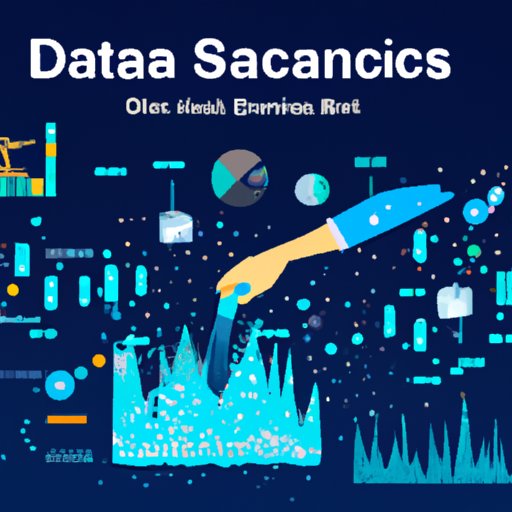Introduction
What is data science? Data science is an interdisciplinary field that uses scientific methods, processes, algorithms, and systems to extract knowledge and insights from structured and unstructured data. It is a rapidly growing field, as more and more businesses recognize the value of data-driven decision making. But what does data science entail? This article will explore what data science involves and provide a comprehensive guide to the different types, techniques, tools, and components used in the process.
An Overview of Data Science: What Does it Entail?
Data science is a broad field that encompasses a range of different activities. According to IBM, “Data science is a multi-disciplinary field that uses scientific methods, processes, algorithms, and systems to extract knowledge and insights from structured and unstructured data.” In other words, it is the process of extracting meaningful insights from data so that businesses can make informed decisions.
Data science has many benefits. It allows businesses to uncover patterns and trends in their data that they would otherwise not be able to see. It also helps them to gain a better understanding of their customers and their needs, allowing them to tailor their products and services accordingly. In addition, data science can help businesses to identify new opportunities for growth and improvement.
A Comprehensive Guide to Data Science: What is Involved?
Data science involves a range of different activities. There are several different types of data science, including predictive analytics, machine learning, and deep learning. Each type requires different techniques and tools, which we will explore in detail below.
Different Types of Data Science
Predictive analytics is the use of data and statistical models to predict future outcomes. It is used by businesses to anticipate customer behavior and trends, as well as to make business decisions. Machine learning is the use of algorithms to detect patterns and learn from data. It is used to automate processes and identify potential problems before they occur. Deep learning is a subset of machine learning that uses artificial neural networks to process data. It is used for complex tasks such as image and speech recognition.
Techniques Used in Data Science
Data scientists use a variety of techniques to analyze data. These include regression analysis, classification, clustering, and natural language processing. Regression analysis is used to identify relationships between variables. Classification is used to identify categories or groups within a dataset. Clustering is used to group similar items together. Natural language processing is used to analyze text data.
Tools Used in Data Science
Data scientists use a variety of tools to analyze data. These include Python, R, SQL, Tableau, and Hadoop. Python is a programming language used for data analysis and manipulation. R is another programming language used for data analysis and visualization. SQL is a query language used to manage databases. Tableau is a data visualization tool used to create interactive charts and graphs. Hadoop is a distributed computing platform used to store and process large amounts of data.
The Different Components of Data Science: What Do They Mean?
Data science is made up of three main components: data collection, data analysis, and data visualization. Data collection involves gathering data from various sources such as surveys, interviews, and online sources. Data analysis involves cleaning, transforming, and analyzing the data. Data visualization involves creating visuals such as charts and graphs to communicate the results of the analysis.
Exploring the Fundamentals of Data Science: What’s Required?
To become a successful data scientist, there are certain fundamentals that you need to know. You should have a good understanding of statistics and be comfortable working with numbers. You should also have some knowledge of programming languages such as Python and R. Additionally, you should be familiar with databases and how to work with them.
The Role of Data Science: What Does It Encompass?
Data science plays an important role in today’s world. It can be used to automate tasks, enhance business decisions, and improve efficiency. Automation is becoming increasingly important in the workplace, as it allows businesses to reduce costs and increase productivity. Data science can also be used to make better business decisions by identifying patterns and trends in data. Finally, it can help businesses to improve their efficiency by providing insights into their operations.
Understanding the Process of Data Science: How Does It Work?
Data science is a complex process that involves a number of steps. The first step is collecting data from various sources. This data then needs to be cleaned and prepared for analysis. Once the data has been prepared, it can be analyzed using various techniques and tools. The results of the analysis need to be interpreted and communicated to stakeholders. Finally, the results can be used to make decisions or take action.
Conclusion
Data science is an interdisciplinary field that uses scientific methods, processes, algorithms, and systems to extract knowledge and insights from structured and unstructured data. It is a rapidly growing field, as more and more businesses recognize the value of data-driven decision making. This article explored what data science entails, including the different types, techniques, tools, and components used in the process. Data science has many benefits, including helping businesses to uncover patterns and trends in their data, as well as to automate tasks, enhance business decisions, and improve efficiency.
(Note: Is this article not meeting your expectations? Do you have knowledge or insights to share? Unlock new opportunities and expand your reach by joining our authors team. Click Registration to join us and share your expertise with our readers.)
